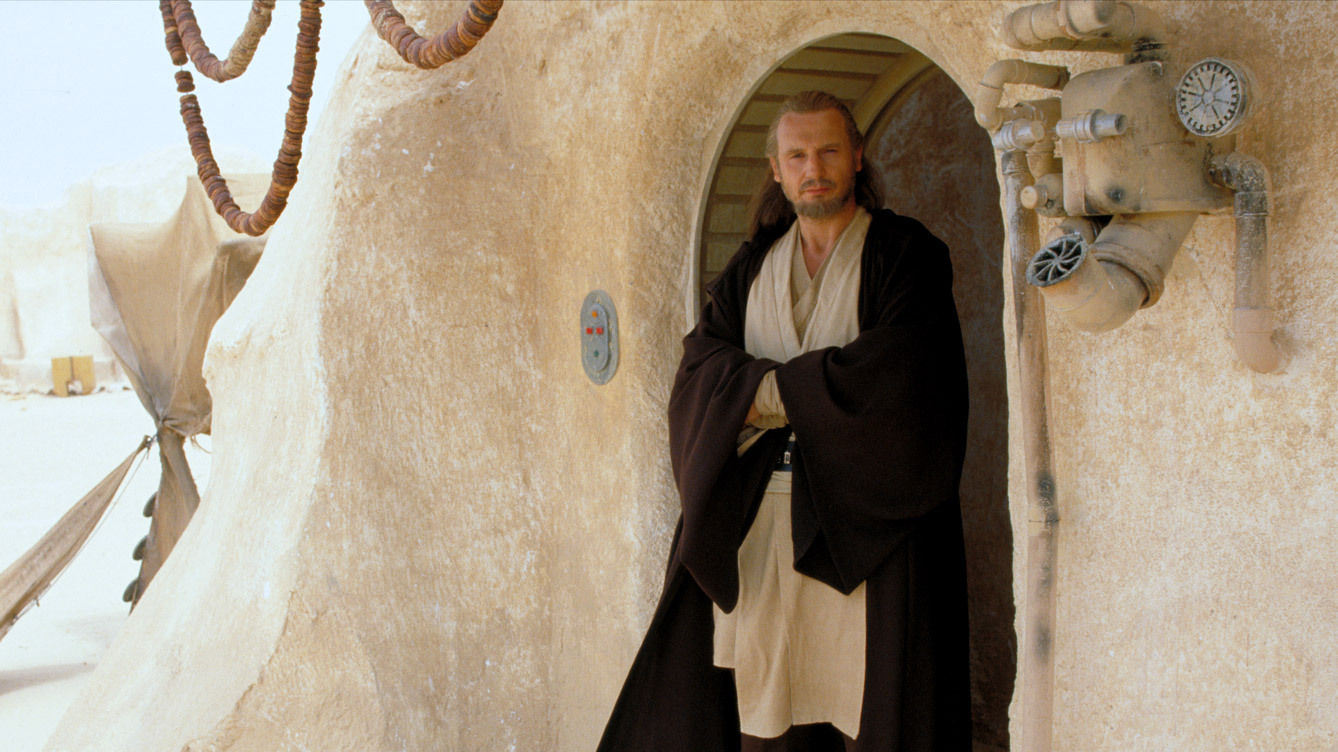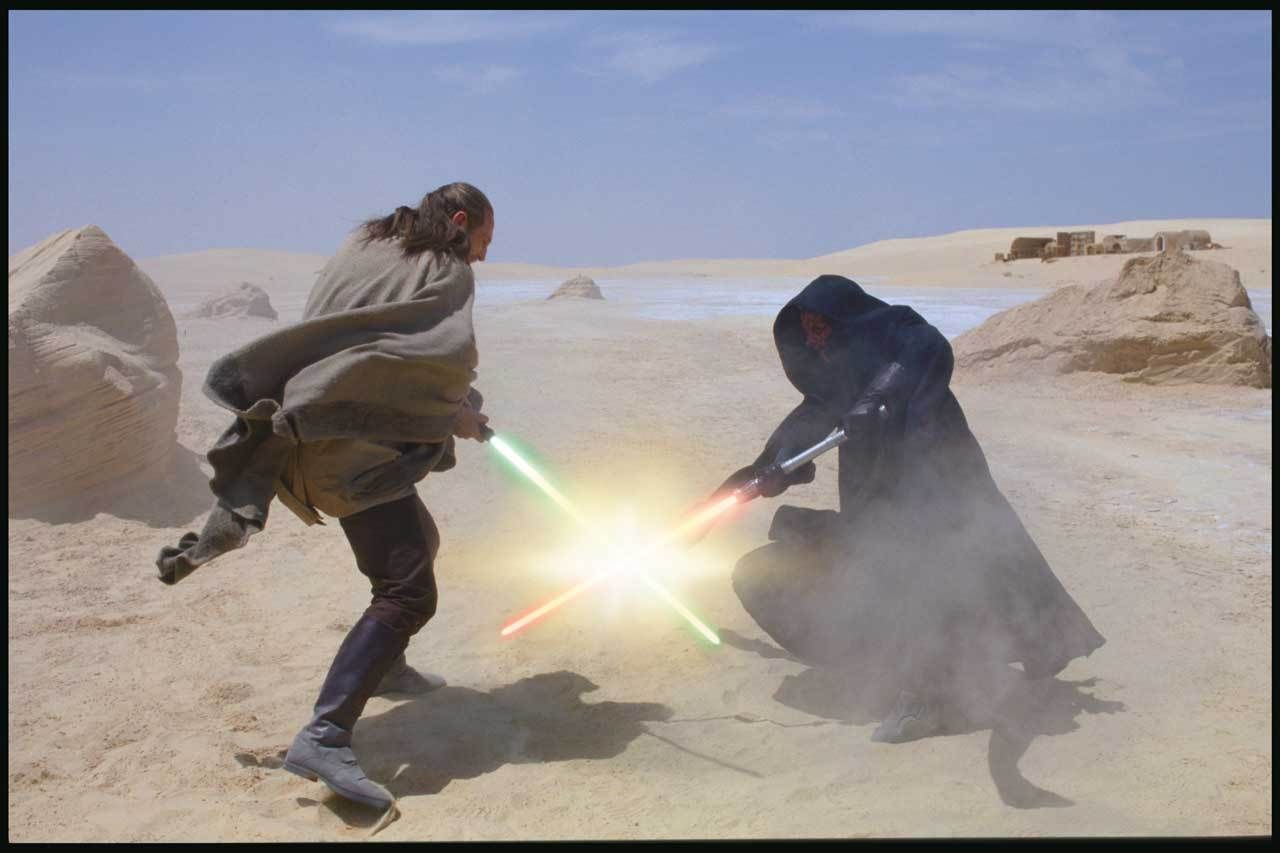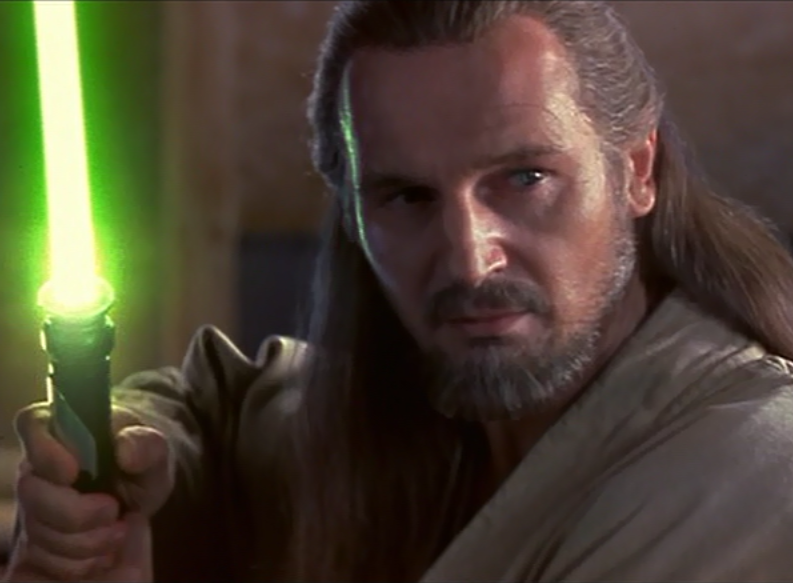The original bad boy Jedi. A maverick Jedi Master indirectly responsible for Luke Skywalker rising above the cloistered folly of the old Jedi Order. He has a rich history despite appearing, and dying, in only a single film.
Qui-Gon Jinn
However you feel about the Prequel Trilogy, one of its greatest assets is Qui-Gon Jinn—if you can pretend he never said the word “Midichlorians“. Even though he is introduced and killed in Episode 1: The Phantom Menace![]() , and is scripted to do and say many things Star Wars fans find strange, Jedi Master Qui-Gon Jinn struck a chord with fans. Despite his limited screen time, he has since reappeared.
, and is scripted to do and say many things Star Wars fans find strange, Jedi Master Qui-Gon Jinn struck a chord with fans. Despite his limited screen time, he has since reappeared.

Although never filmed, Jinn was originally scripted to re-appear as a Force ghost in Episode III: Revenge of the Sith.![]() The scene would have had Jinn speaking with Yoda regarding Anakin. It wasn’t included in the film, but a reference to it was. “An old friend has learned the path to immortality. One who has returned from the netherworld of the Force, your old master,“ Yoda informs Obi-Wan Kenobi at the end of the film. “How to commune with him, I will teach you.“ The novelization of Revenge of the Sith retains the original scene that never made it into the movie.
The scene would have had Jinn speaking with Yoda regarding Anakin. It wasn’t included in the film, but a reference to it was. “An old friend has learned the path to immortality. One who has returned from the netherworld of the Force, your old master,“ Yoda informs Obi-Wan Kenobi at the end of the film. “How to commune with him, I will teach you.“ The novelization of Revenge of the Sith retains the original scene that never made it into the movie.
Despite Yoda’s proclamation and Kenobi’s surprise at it coming within minutes of the end of the Prequel Trilogy, a potential in-canon contradiction arises from it as, later, in real world time, but long before in the story timeline, Jinn as already made contact with Kenobi from beyond death. In the episode of the animated Star Wars: The Clone Wars![]() titled “Ghost of Mortis,” Jinn appears to Kenobi as a Force ghost. When Kenobi asks how his late master was able to perform such a feat, Jinn explains that Mortis, the planet on which they conversed, was a conduit for the Force and acted as an amplifier. Interpreted strictly, the later conversation between Yoda and Kenobi about Jinn does not create a contradiction with this earlier communication from “the netherworld of the Force.” Put simply, the planet Mortis was the means by which Jinn communicated with Kenobi, but he apparently later learned how to do it without such an aid. That explanation supports, and is supported by, an even earlier discussion Jinn has with Yoda on a different episode of Star Wars: The Clone Wars. At that time, Jinn could only send his disembodied voice to Yoda. During the manifestation on Mortis he was both audible and visible, a complete Force Ghost.
titled “Ghost of Mortis,” Jinn appears to Kenobi as a Force ghost. When Kenobi asks how his late master was able to perform such a feat, Jinn explains that Mortis, the planet on which they conversed, was a conduit for the Force and acted as an amplifier. Interpreted strictly, the later conversation between Yoda and Kenobi about Jinn does not create a contradiction with this earlier communication from “the netherworld of the Force.” Put simply, the planet Mortis was the means by which Jinn communicated with Kenobi, but he apparently later learned how to do it without such an aid. That explanation supports, and is supported by, an even earlier discussion Jinn has with Yoda on a different episode of Star Wars: The Clone Wars. At that time, Jinn could only send his disembodied voice to Yoda. During the manifestation on Mortis he was both audible and visible, a complete Force Ghost.

Although The Phantom Menace opens with Jinn already a Jedi Master—and one set on playing fast and loose with the Force and the rules of the Jedi Order—his backstory has been chronicled in Legacy ne Expanded Universe novels.
Like most Jedi of the Republic, Jinn’s ability in the Force was identified in infancy, and he was subsequently taken from his family and raised in the Jedi Temple. His early training is uneventful, but we discover Jinn’s evolution as a Jedi Knight and Master through The Rising Force![]() , The Dark Rival
, The Dark Rival![]() , and sixteen other books in the young adult Jedi Apprentice series
, and sixteen other books in the young adult Jedi Apprentice series ![]() . The series primarily focuses on Jinn and his Padawan, Obi-Wan Kenobi, though we learn that Kenobi was not Jinn’s first apprentice. His first, Xanatos, was lost to the Dark Side. Jinn took the event as his personal failure as a teacher and spent many of the following years refusing to train another Padawan. His initial meeting with Kenobi as a twelve-year-old boy doesn’t change his mind. While recognizing Kenobi’s skills, Jinn believes the boy’s anger makes him a poor candidate for Jedi training and a risk for falling to the Dark Side like Xanatos.
. The series primarily focuses on Jinn and his Padawan, Obi-Wan Kenobi, though we learn that Kenobi was not Jinn’s first apprentice. His first, Xanatos, was lost to the Dark Side. Jinn took the event as his personal failure as a teacher and spent many of the following years refusing to train another Padawan. His initial meeting with Kenobi as a twelve-year-old boy doesn’t change his mind. While recognizing Kenobi’s skills, Jinn believes the boy’s anger makes him a poor candidate for Jedi training and a risk for falling to the Dark Side like Xanatos.

Jinn eventually relents and takes Kenobi as his apprentice ironically because of Xanatos. Xanatos, leading a criminal corporation, plots to kill his old master, but, with Kenobi’s aid, Jinn escapes the trap.
Further into the Jedi Apprentice series, approaching the time of the Prequel Trilogy, Jinn works with his master, Count Dooku. Aided by now Jedi Knight Kenobi, Jinn and Dooku begin a diplomatic mission only to have it interrupted by pirates led by a rogue Jedi. During the battle with this fallen Jedi, Lorian Nod, Dooku is overtaken by anger at his friend Nod’s betrayal. Jinn’s strong will and quick actions prevent Dooku from murdering Nod while foreshadowing Dooku’s eventual fall to the Dark Side.

Although Jinn appears in Star Wars: Republic![]() and other comics from Darkhorse, and is mentioned, usually posthumously, in a number of novels and comics, it’s the Jedi Apprentice Series written almost exclusively by Jude Watson that gives Jinn a full biography. It details his growing dissidence with the Jedi Code and its enforcement by the authority of the Jedi Council, which, in turn, made Jinn such a maverick Jedi Master who passed along the crucial, unapproved lessons and attitudes that would eventually bring balance to the Force through Luke Skywalker by way of Obi-Wan Kenobi’s teachings, teachings that Qui-Gon Jinn helped define. While the Jedi Order practiced meditation to discern the future, Jinn lived in, and encouraged in his Padawan a focus on, the moment, using the Force to provide insight into the present and inform one’s instincts, which he also believed should be followed. These same beliefs are expressed in Luke Skywalker’s actions thirty years after Jinn’s death when Yoda, the ultimate example of the Jedi Order and its rules, warns Luke Skywalker to ignore the immediate danger faced by Princess Leia and Han Solo on Cloud City, and to remain on Dagobah and continue his training. Fortunately for the galaxy, Skywalker ignores Yoda and follows the twice-removed, and through Kenobi now tempered and refined, way of Jinn.
and other comics from Darkhorse, and is mentioned, usually posthumously, in a number of novels and comics, it’s the Jedi Apprentice Series written almost exclusively by Jude Watson that gives Jinn a full biography. It details his growing dissidence with the Jedi Code and its enforcement by the authority of the Jedi Council, which, in turn, made Jinn such a maverick Jedi Master who passed along the crucial, unapproved lessons and attitudes that would eventually bring balance to the Force through Luke Skywalker by way of Obi-Wan Kenobi’s teachings, teachings that Qui-Gon Jinn helped define. While the Jedi Order practiced meditation to discern the future, Jinn lived in, and encouraged in his Padawan a focus on, the moment, using the Force to provide insight into the present and inform one’s instincts, which he also believed should be followed. These same beliefs are expressed in Luke Skywalker’s actions thirty years after Jinn’s death when Yoda, the ultimate example of the Jedi Order and its rules, warns Luke Skywalker to ignore the immediate danger faced by Princess Leia and Han Solo on Cloud City, and to remain on Dagobah and continue his training. Fortunately for the galaxy, Skywalker ignores Yoda and follows the twice-removed, and through Kenobi now tempered and refined, way of Jinn.

Despite having the best hair in the Jedi Order, Qui-Gon Jinn is not a popular role-playing game character. He does appear in all Star Wars tabletop and board games set in, or including, the timeline of the Prequel Trilogy. He is more commonly found in video games covering that time period, many of which capture his personality while leaving out the more derided elements of the Prequel Trilogy.
What in the Galaxy are those Symbols?
Throughout Who in the Galaxy is That? profiles you may encounter one or more of the following symbols.
Here’s what they mean:
 Canon
Canon- Sources and media cited as canon contain information that is officially part of the Star Wars film universe, which also includes non-film media such as books, comic books, games, and more. This means the information is officially part of the history of Star Wars that appears in the films. It came from, or may appear within or influence, the events of a Star Wars film.
 Legends
Legends- Following Return of the Jedi, George Lucas stated that he would not make other Star Wars movies. He then opened Star Wars to other creators and media. Carefully overseen by Lucas’s company, Lucas Arts, hundreds of new Star Wars novels, comic books and graphic novels, video games, and television shows were created to expand the Star Wars universe and tell stories in all directions—from thousands of years before Luke Skywalker was born to thousands of years after, from filling in the histories of the greatest Star Wars legends to bringing life to every background alien in the Cantina scene. This was the Star Wars Expanded Universe, and it was all canon until new Star Wars films were once again possible. Disney and Lucas Arts then found themselves penned in by the massive amount of material from other creators and projects. They simply couldn’t make Episode VII and beyond because every moment in the lives of the major characters of Han, Luke, Leia, and others had already been chronicled in the Expanded Universe, and very little of that could easily be translated to feature films easily followed by, and appealing to, the many different types of Star Wars fans who loved the Original Trilogy. As a result, a large portion of the formerly-canon Expanded Universe stories were declared non-canon, unofficial in terms of the film continuity. The stories still exist and continue to expand, but now in an alternate reality called Star Wars Legends while other new stories are created alongside them within the universe of the films.
 Fandom-Created
Fandom-Created- Though rare, you’ll see this symbol appear from time-to-time in Who in the Galaxy is That? Star Wars fans are many and varied, and they like to create their own movies, stories, comics, artwork, and more based in the Star Wars universe. Occasionally, a fan-created work is so good and becomes so popular that it gains super star status all on its own. When such rarities relate to the characters profiled in Who in the Galaxy is That?, they are identified by the Fandom-Created symbol.
Suggest a Character to Profile
Have you ever wondered, “who in the galaxy is that?” Tell us in the comments who you’ve wondered about in the Star Wars universe of films, books, comics, games, and even toys. If you know the character’s name, tell us, but if you don’t know a name, tell us where we can find the character that has piqued your curiosity. Something like “the third bounty hunter from the left in the Star Destroyer scene in Empire Strikes Back” works quite well in directing us to who you’re thinking about. Whomever you wonder about, we might just profile in Who in the Galaxy is That?


